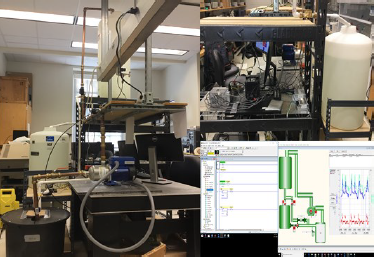Engineering students at the University of Delaware’s Department of Electrical and Computer Engineering have a vision and they used the power of AFT Fathom to investigate.
In April 2018, Applied Flow Technology (AFT) donated AFT Fathom to Josh Dubey and Keith Goossen to investigate an energy efficient pump speed control algorithm for controlling sump level. AFT Fathom is fluid dynamic simulation software for engineers, used to calculate pressure drop and flow distribution in liquid and low velocity gas piping and ducting systems. AFT is honored to assist students who are working on research projects so we donate full licenses to contribute to their education.
As an industry leading modeling, simulation and analysis software, engineers around the world have continuously utilized AFT Fathom since 1996. The software models piping and ducting systems for hydraulic engineering projects ranging from expansion verification to troubleshooting production issues. It is a popular tool that can be found in any successful engineer’s toolbox as it’s known for it’s ease of use and highly accurate results.
Engineers appreciate the intuitive interface and can confidently make sustainable models they can pass on to future project engineers.
In their paper, Dubey and Goossen say, “In general, savings in pump energy can be achieved in two main ways. One is by designing more efficient pumps. Another, discussed and presented here, is improving pump performance with effective control strategies.” In this paper, the duo reports a new control algorithm for sump pumping systems, for example in wastewater treatment plants, that results in up to 4 % savings compared to the currently used control algorithms.
Applied Flow Technology values young engineers’ ingenuity and this dynamic duo is no exception. This project is ongoing and we look forward to seeing how these bright minds use AFT Fathom to contribute to future energy reduction.
Paper Title: Investigation of an Energy Efficient Pump Speed Control Algorithm for Controlling Sump Level
Abstract: This paper explores a new nonlinear control algorithm for variable speed centrifugal pumps at water/wastewater pump stations that leads to specific energy savings over the conventional linear one. The algorithm is useful for facilities where pump speed is a linear function of liquid level in order to transport fluid and smooth inflow peaks. A non-linearity in the form of a quadratic term is added to the conventional linear one in order to produce efficiency gains, with a single parameter, curvature, varied to optimize energy savings. Results obtained by implementing the new algorithm on a pilot-scale pump station show significant energy savings for fixed pump flow, with a parabolic correlation of specific energy savings versus curvature of the nonlinear quadratic determined. In addition, the cost of implementing this algorithm is minimal to none, so the work presented has major industrial potential.




